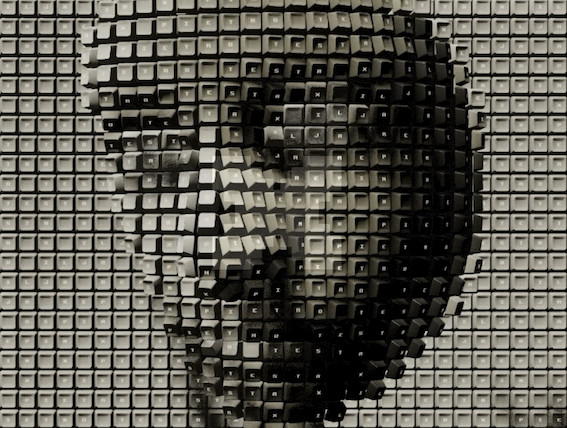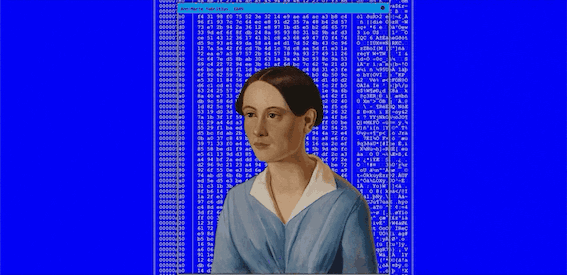MODES TO TRIGGER A MUSEUM COLLECTION
New York, June 2025
On Remix the Archive and Finland’s Open Image Policy
In a former Dunkin’ Donuts in Manhattan’s Financial District, a soft bluish glow spills onto the sidewalk. Inside, visitors press small buttons to trigger large screens. Each click generates a new artwork: vivid, flickering, algorithmic. Remix the Archive, now on view at Dunkunsthalle (yes, part Dunkin’, part Kunsthalle), gathers ten works built from the Finnish National Gallery’s digitized, public domain art collection.
The exhibition was created by the Finnish National Gallery through an open call. In New York, it is presented by the Finnish Cultural Institute and supported by the Consulate General of Finland. Artists and creative coders from more than fifty countries including algorithm-scene fixtures Newyellow, Blas.v, Nahuel Gerth, and Tuomo Rainio were invited to work with a vast dataset: a digitized collection of over 25,000 public domain images from the Finnish National Gallery.
Right The Artist Code Shaderism, picture by Juho Huttunen
The archive includes mostly nineteenth- and early twentieth-century portraits, landscapes, still lifes, and allegorical scenes by canonical Finnish painters. This was a period in which art played a central role in shaping Finland’s national identity. In the late 1800s, during the country’s nation-building period under Russian rule, artists turned to the Kalevala, a national epic compiled from oral folklore, to construct a mythic visual identity. That kind of cultural scaffolding once stabilized the idea of the nation through images, objects, and exhibition architecture.
Today, the same works circulate under radically different conditions. Once an artist has been dead for seventy years, their works enter the public domain in Finland. The Finnish National Gallery’s collection was released under a Creative Commons Zero license, which means it can be reused, modified, or redistributed freely, no permissions required. “We knew we had this huge archive,” says Alvar Mahlberg, who leads digital initiatives at the Finnish National Gallery and helped shape the project. “But the question became: what can we actually do with it?” The stated goal was not preservation, but activation: new publics, new uses, new contexts.
The Artist Code Shaderism
But Remix the Archive doesn’t simply globalize a national repository. It begins to test what a museum collection becomes when (I argue) it enters what Benjamin Bratton calls The Stack—a layered system of computational infrastructure, interfaces, governance, and data flows. As Mahlberg explains, digitization is not just image capture. “We have been digitizing most of the material and artworks we have, not just to take pictures, but to ensure the metadata is accurate.” A museum object is no longer just its visual form, it includes titles, artist names, exhibition histories, conservation records, tags, dates, and techniques. In other words, an artwork is now also a dataset.
The pieces in the show were composed from this metadata. One artist scraped conservation notes to build generative glitches. Another extracted pose data from over 5,000 archival images to construct a shifting crowd of limbs and gestures. A weaving algorithm, inspired by traditional ryijy rugs, decomposed Finnish landscapes into tangled digital tapestries. Elsewhere, a broken interface flickered endlessly, failing to resolve a painting from the archive.
Right Perseverance
“Generative in the sense that it creates new outputs,” Mahlberg explains. “None of what you see here is final. They are all algorithms.” Behind each screen is a system authored by the artist, a program that evolves, mutates, and recombines. “The algorithm is the artwork. The artists created it, modified it, and are responsible for what you see.” He also points out the strength of the scene’s community. “If you go in it, you’ll find a lot of people who are enthusiastic and responsive.”
The exhibition resists passive viewing. “I went to this event in Paris where everything was on a timer, like a slideshow,” Mahlberg recalls. “And I remember thinking, I would love to explore the algorithm myself.” Here, the viewer does just that. Rather than watching, they click, loop, trigger. Less flâneur, more operator. “Some older visitors really like the slower works,” he adds. “Younger people tend to want faster visuals. They have TikTok brains!”
Re-frame Agoston Nagy
The exhibition’s physical staging picks up on this logic of activation. Designed by Helsinki-based Nervin Architecture and installed in four days, it retains much of the original donut shop’s interior: white tiles from floor to ceiling. Matching tiled console podiums and simple screen frames were added, giving the room a quiet precision. One colleague of Mahlberg apparently called it a cyberpunk bathhouse, somewhere between a data center and a spa. The viewer is left in between states: neither controlling nor observing, but caught in a loop of contemplation and response.
The show was first exhibited in an old Helsinki office building and now reappears in a defunct storefront in New York. “If you go out on the street and ask people what a museum is,” Mahlberg says, “they say, ‘the building.’ But if you ask people who work in a museum, they say, ‘the collection and the exhibitions.’” This distinction matters. The project implies that the museum need not be confined to typological traditions. It can and should be dispersed, recombined, triggered.
Right Perseverance
Museums, particularly national ones, have historically emerged from Enlightenment-era ideals to classify knowledge and construct public identity. As Tony Bennett writes in The Birth of the Museum (1995), such institutions functioned as “civic machines,” producing publics through visibility, spatial control, and classification. In that schema, the museum served as a stabilizing force: a place to anchor national narratives in material form. But today, the collection circulates and performs through fragments.
What’s clear is that this show isn’t a conclusion—it’s a prototype. It doesn’t define the future of the museum, but it lays out a possible one: porous collections, distributed authorship, algorithms as curators, publics as users. The institutional frame displayed here is shifting. What matters is not just what the museum displays, but how it listens, how it loops, and when it lets go.
This shift also implies a different relationship to the public domain. “We don’t own any of these artworks, they are owned by the artists,” Mahlberg emphasizes. “That was important for us, to allow the artist to have full ownership.” The museum here doesn’t function as a site of possession. It functions as an interface. And the public domain is not a repository of extractable material but rather a feedback system. What happens when artworks generated from open collections loop back into the museum? The cultural scaffolding that once held a nation together is being rewritten in code. The museum, in this formulation, becomes not a static institution but a programmable environment with generative outputs. As Mahlberg puts it, “Next time, I would maybe include more data. Involve more museums. Maybe even companies with interesting data.” The future of the museum may well depend on what happens when it stops holding, and starts triggering.
Remix the Archive is on view from May 9 to June 21, 2025, at Dunkunsthalle, New York.
Left Body Art Lab Nahuel Gerth
Right Perseverance
Perseverance
Text by Ibrahim Kombarji
Installation views by Janne Tuunanen, Alvar Mahlberg, Milla Paananen and Mitja Kaipiainen
All artworks Courtesy of the artist and the Finnish National Gallery



